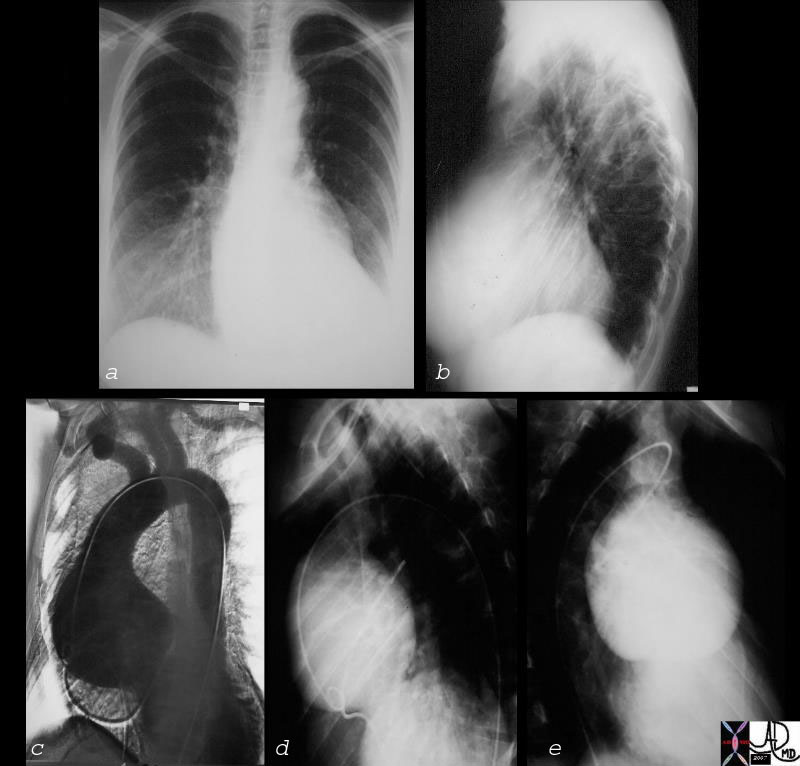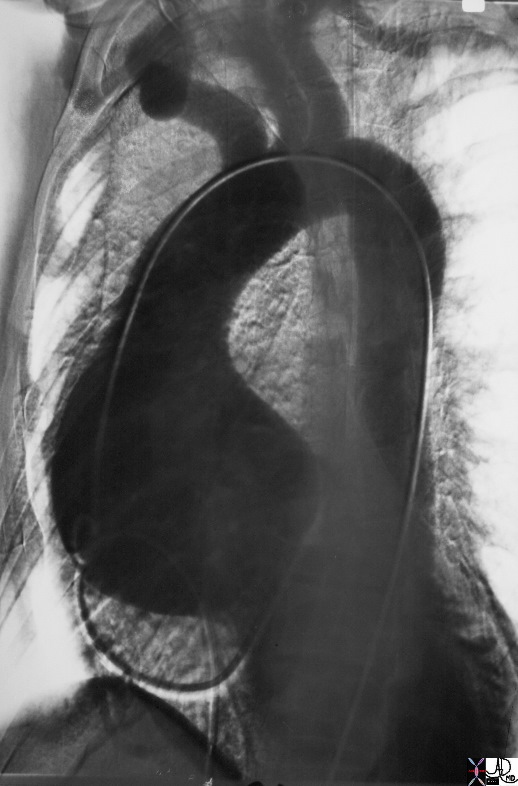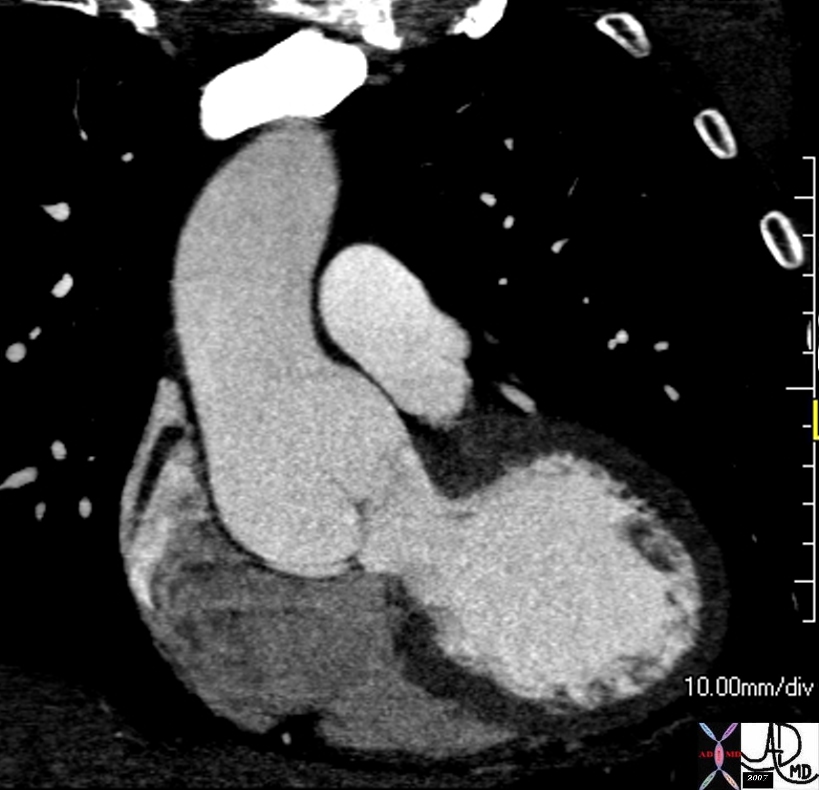DOMElement Object
(
[schemaTypeInfo] =>
[tagName] => table
[firstElementChild] => (object value omitted)
[lastElementChild] => (object value omitted)
[childElementCount] => 1
[previousElementSibling] => (object value omitted)
[nextElementSibling] => (object value omitted)
[nodeName] => table
[nodeValue] =>
Annuloaortic Ectasia with Severe Aortic Regurgitation – Marfan’s Syndrome
35237.800 aorta thoracic annulus bulbous portion sinus annuloaortic ectasia with severe aortic regurgitation Marfan’s syndrome CXR plain film angiogram angiography Courtesy Laura Feldman MD 35241c01
[nodeType] => 1
[parentNode] => (object value omitted)
[childNodes] => (object value omitted)
[firstChild] => (object value omitted)
[lastChild] => (object value omitted)
[previousSibling] => (object value omitted)
[nextSibling] => (object value omitted)
[attributes] => (object value omitted)
[ownerDocument] => (object value omitted)
[namespaceURI] =>
[prefix] =>
[localName] => table
[baseURI] =>
[textContent] =>
Annuloaortic Ectasia with Severe Aortic Regurgitation – Marfan’s Syndrome
35237.800 aorta thoracic annulus bulbous portion sinus annuloaortic ectasia with severe aortic regurgitation Marfan’s syndrome CXR plain film angiogram angiography Courtesy Laura Feldman MD 35241c01
)
DOMElement Object
(
[schemaTypeInfo] =>
[tagName] => td
[firstElementChild] =>
[lastElementChild] =>
[childElementCount] => 0
[previousElementSibling] =>
[nextElementSibling] =>
[nodeName] => td
[nodeValue] => 35237.800 aorta thoracic annulus bulbous portion sinus annuloaortic ectasia with severe aortic regurgitation Marfan’s syndrome CXR plain film angiogram angiography Courtesy Laura Feldman MD 35241c01
[nodeType] => 1
[parentNode] => (object value omitted)
[childNodes] => (object value omitted)
[firstChild] => (object value omitted)
[lastChild] => (object value omitted)
[previousSibling] => (object value omitted)
[nextSibling] => (object value omitted)
[attributes] => (object value omitted)
[ownerDocument] => (object value omitted)
[namespaceURI] =>
[prefix] =>
[localName] => td
[baseURI] =>
[textContent] => 35237.800 aorta thoracic annulus bulbous portion sinus annuloaortic ectasia with severe aortic regurgitation Marfan’s syndrome CXR plain film angiogram angiography Courtesy Laura Feldman MD 35241c01
)
DOMElement Object
(
[schemaTypeInfo] =>
[tagName] => td
[firstElementChild] => (object value omitted)
[lastElementChild] => (object value omitted)
[childElementCount] => 1
[previousElementSibling] =>
[nextElementSibling] =>
[nodeName] => td
[nodeValue] => Annuloaortic Ectasia with Severe Aortic Regurgitation – Marfan’s Syndrome
[nodeType] => 1
[parentNode] => (object value omitted)
[childNodes] => (object value omitted)
[firstChild] => (object value omitted)
[lastChild] => (object value omitted)
[previousSibling] => (object value omitted)
[nextSibling] => (object value omitted)
[attributes] => (object value omitted)
[ownerDocument] => (object value omitted)
[namespaceURI] =>
[prefix] =>
[localName] => td
[baseURI] =>
[textContent] => Annuloaortic Ectasia with Severe Aortic Regurgitation – Marfan’s Syndrome
)
https://beta.thecommonvein.net/wp-content/uploads/2023/05/35237.800.jpg https://beta.thecommonvein.net/wp-content/uploads/2023/05/35241c01.jpg
http://thecommonvein.net/media/35237.800.jpg
DOMElement Object
(
[schemaTypeInfo] =>
[tagName] => table
[firstElementChild] => (object value omitted)
[lastElementChild] => (object value omitted)
[childElementCount] => 1
[previousElementSibling] => (object value omitted)
[nextElementSibling] => (object value omitted)
[nodeName] => table
[nodeValue] =>
Sinotubular Ectasia – Marfan’s Syndrome
72712 thoracic aorta sinus of Valsalva aortic sinuses sinotubular junction of ascending aorta sinotubular ectasia fx dilated CTscan Courtesy Ashley DAvidoff MD 72709
[nodeType] => 1
[parentNode] => (object value omitted)
[childNodes] => (object value omitted)
[firstChild] => (object value omitted)
[lastChild] => (object value omitted)
[previousSibling] => (object value omitted)
[nextSibling] => (object value omitted)
[attributes] => (object value omitted)
[ownerDocument] => (object value omitted)
[namespaceURI] =>
[prefix] =>
[localName] => table
[baseURI] =>
[textContent] =>
Sinotubular Ectasia – Marfan’s Syndrome
72712 thoracic aorta sinus of Valsalva aortic sinuses sinotubular junction of ascending aorta sinotubular ectasia fx dilated CTscan Courtesy Ashley DAvidoff MD 72709
)
DOMElement Object
(
[schemaTypeInfo] =>
[tagName] => td
[firstElementChild] =>
[lastElementChild] =>
[childElementCount] => 0
[previousElementSibling] =>
[nextElementSibling] =>
[nodeName] => td
[nodeValue] => 72712 thoracic aorta sinus of Valsalva aortic sinuses sinotubular junction of ascending aorta sinotubular ectasia fx dilated CTscan Courtesy Ashley DAvidoff MD 72709
[nodeType] => 1
[parentNode] => (object value omitted)
[childNodes] => (object value omitted)
[firstChild] => (object value omitted)
[lastChild] => (object value omitted)
[previousSibling] => (object value omitted)
[nextSibling] => (object value omitted)
[attributes] => (object value omitted)
[ownerDocument] => (object value omitted)
[namespaceURI] =>
[prefix] =>
[localName] => td
[baseURI] =>
[textContent] => 72712 thoracic aorta sinus of Valsalva aortic sinuses sinotubular junction of ascending aorta sinotubular ectasia fx dilated CTscan Courtesy Ashley DAvidoff MD 72709
)
DOMElement Object
(
[schemaTypeInfo] =>
[tagName] => td
[firstElementChild] => (object value omitted)
[lastElementChild] => (object value omitted)
[childElementCount] => 2
[previousElementSibling] =>
[nextElementSibling] =>
[nodeName] => td
[nodeValue] =>
Sinotubular Ectasia – Marfan’s Syndrome
[nodeType] => 1
[parentNode] => (object value omitted)
[childNodes] => (object value omitted)
[firstChild] => (object value omitted)
[lastChild] => (object value omitted)
[previousSibling] => (object value omitted)
[nextSibling] => (object value omitted)
[attributes] => (object value omitted)
[ownerDocument] => (object value omitted)
[namespaceURI] =>
[prefix] =>
[localName] => td
[baseURI] =>
[textContent] =>
Sinotubular Ectasia – Marfan’s Syndrome
)
https://beta.thecommonvein.net/wp-content/uploads/2023/06/72712.jpg https://beta.thecommonvein.net/wp-content/uploads/2023/06/72709.jpg
http://thecommonvein.net/media/72712.jpg
DOMElement Object
(
[schemaTypeInfo] =>
[tagName] => table
[firstElementChild] => (object value omitted)
[lastElementChild] => (object value omitted)
[childElementCount] => 1
[previousElementSibling] =>
[nextElementSibling] =>
[nodeName] => table
[nodeValue] =>
Annuloaortic Ectasia
The Common Vein Copyright 2007
Ashley Davidoff MD
Jessica Humphries
Definition
Annuloaortic ectasia is an idiopathic disease characterized by the dilation of the proximal aorta and aortic annulus.
The likely causes of annuloaortic ectasia are abnormalities in collagen cross-linking or in elastic tissues.
The results of this disease are aortic regurgitation, thoracic aortic dissection, aneurysm, and rupture.
The most common diagnostic procedures for annuloaortic ectasia is echocardiography.
This disease is usually treated with corrective surgery, involving replacement of the aortic valve, resection of the aneurysmal aorta, and re-implantation of the coronary arteries.
Statistics
5-10% of patients undergoing aortic valve replacement for pure aortic regurgitation have annuloaortic ectasia.
Causative Factors
Probably due to abnormalities in collagen cross-linking or elastic tissue Classic Marfan syndrome Some overlying features of Marfan M:F 2-8:1 4th to 6th decade
Diagnosis
Sinotubular Ectasia – Marfan’s Syndrome
72712 thoracic aorta sinus of Valsalva aortic sinuses sinotubular junction of ascending aorta sinotubular ectasia fx dilated CTscan Courtesy Ashley DAvidoff MD 72709
Annuloaortic Ectasia with Severe Aortic Regurgitation – Marfan’s Syndrome
35237.800 aorta thoracic annulus bulbous portion sinus annuloaortic ectasia with severe aortic regurgitation Marfan’s syndrome CXR plain film angiogram angiography Courtesy Laura Feldman MD 35241c01
Clinical
Marfan’s syndrome or Marfanoid features May have features of aortic regurgitation or acute aortic dissection RX Surgical correction involves replacement of the aortic valve and resection of the aneurysmal aorta with reimplantation of the coronary arteries
[nodeType] => 1
[parentNode] => (object value omitted)
[childNodes] => (object value omitted)
[firstChild] => (object value omitted)
[lastChild] => (object value omitted)
[previousSibling] =>
[nextSibling] => (object value omitted)
[attributes] => (object value omitted)
[ownerDocument] => (object value omitted)
[namespaceURI] =>
[prefix] =>
[localName] => table
[baseURI] =>
[textContent] =>
Annuloaortic Ectasia
The Common Vein Copyright 2007
Ashley Davidoff MD
Jessica Humphries
Definition
Annuloaortic ectasia is an idiopathic disease characterized by the dilation of the proximal aorta and aortic annulus.
The likely causes of annuloaortic ectasia are abnormalities in collagen cross-linking or in elastic tissues.
The results of this disease are aortic regurgitation, thoracic aortic dissection, aneurysm, and rupture.
The most common diagnostic procedures for annuloaortic ectasia is echocardiography.
This disease is usually treated with corrective surgery, involving replacement of the aortic valve, resection of the aneurysmal aorta, and re-implantation of the coronary arteries.
Statistics
5-10% of patients undergoing aortic valve replacement for pure aortic regurgitation have annuloaortic ectasia.
Causative Factors
Probably due to abnormalities in collagen cross-linking or elastic tissue Classic Marfan syndrome Some overlying features of Marfan M:F 2-8:1 4th to 6th decade
Diagnosis
Sinotubular Ectasia – Marfan’s Syndrome
72712 thoracic aorta sinus of Valsalva aortic sinuses sinotubular junction of ascending aorta sinotubular ectasia fx dilated CTscan Courtesy Ashley DAvidoff MD 72709
Annuloaortic Ectasia with Severe Aortic Regurgitation – Marfan’s Syndrome
35237.800 aorta thoracic annulus bulbous portion sinus annuloaortic ectasia with severe aortic regurgitation Marfan’s syndrome CXR plain film angiogram angiography Courtesy Laura Feldman MD 35241c01
Clinical
Marfan’s syndrome or Marfanoid features May have features of aortic regurgitation or acute aortic dissection RX Surgical correction involves replacement of the aortic valve and resection of the aneurysmal aorta with reimplantation of the coronary arteries
)
DOMElement Object
(
[schemaTypeInfo] =>
[tagName] => td
[firstElementChild] =>
[lastElementChild] =>
[childElementCount] => 0
[previousElementSibling] =>
[nextElementSibling] =>
[nodeName] => td
[nodeValue] => 35237.800 aorta thoracic annulus bulbous portion sinus annuloaortic ectasia with severe aortic regurgitation Marfan’s syndrome CXR plain film angiogram angiography Courtesy Laura Feldman MD 35241c01
[nodeType] => 1
[parentNode] => (object value omitted)
[childNodes] => (object value omitted)
[firstChild] => (object value omitted)
[lastChild] => (object value omitted)
[previousSibling] => (object value omitted)
[nextSibling] => (object value omitted)
[attributes] => (object value omitted)
[ownerDocument] => (object value omitted)
[namespaceURI] =>
[prefix] =>
[localName] => td
[baseURI] =>
[textContent] => 35237.800 aorta thoracic annulus bulbous portion sinus annuloaortic ectasia with severe aortic regurgitation Marfan’s syndrome CXR plain film angiogram angiography Courtesy Laura Feldman MD 35241c01
)
DOMElement Object
(
[schemaTypeInfo] =>
[tagName] => td
[firstElementChild] => (object value omitted)
[lastElementChild] => (object value omitted)
[childElementCount] => 2
[previousElementSibling] =>
[nextElementSibling] =>
[nodeName] => td
[nodeValue] => Annuloaortic Ectasia with Severe Aortic Regurgitation – Marfan’s Syndrome
[nodeType] => 1
[parentNode] => (object value omitted)
[childNodes] => (object value omitted)
[firstChild] => (object value omitted)
[lastChild] => (object value omitted)
[previousSibling] => (object value omitted)
[nextSibling] => (object value omitted)
[attributes] => (object value omitted)
[ownerDocument] => (object value omitted)
[namespaceURI] =>
[prefix] =>
[localName] => td
[baseURI] =>
[textContent] => Annuloaortic Ectasia with Severe Aortic Regurgitation – Marfan’s Syndrome
)
DOMElement Object
(
[schemaTypeInfo] =>
[tagName] => td
[firstElementChild] =>
[lastElementChild] =>
[childElementCount] => 0
[previousElementSibling] =>
[nextElementSibling] =>
[nodeName] => td
[nodeValue] => 72712 thoracic aorta sinus of Valsalva aortic sinuses sinotubular junction of ascending aorta sinotubular ectasia fx dilated CTscan Courtesy Ashley DAvidoff MD 72709
[nodeType] => 1
[parentNode] => (object value omitted)
[childNodes] => (object value omitted)
[firstChild] => (object value omitted)
[lastChild] => (object value omitted)
[previousSibling] => (object value omitted)
[nextSibling] => (object value omitted)
[attributes] => (object value omitted)
[ownerDocument] => (object value omitted)
[namespaceURI] =>
[prefix] =>
[localName] => td
[baseURI] =>
[textContent] => 72712 thoracic aorta sinus of Valsalva aortic sinuses sinotubular junction of ascending aorta sinotubular ectasia fx dilated CTscan Courtesy Ashley DAvidoff MD 72709
)
https://beta.thecommonvein.net/wp-content/uploads/2023/05/35237.800.jpg https://beta.thecommonvein.net/wp-content/uploads/2023/05/35241c01.jpg
DOMElement Object
(
[schemaTypeInfo] =>
[tagName] => td
[firstElementChild] => (object value omitted)
[lastElementChild] => (object value omitted)
[childElementCount] => 3
[previousElementSibling] =>
[nextElementSibling] =>
[nodeName] => td
[nodeValue] =>
Sinotubular Ectasia – Marfan’s Syndrome
[nodeType] => 1
[parentNode] => (object value omitted)
[childNodes] => (object value omitted)
[firstChild] => (object value omitted)
[lastChild] => (object value omitted)
[previousSibling] => (object value omitted)
[nextSibling] => (object value omitted)
[attributes] => (object value omitted)
[ownerDocument] => (object value omitted)
[namespaceURI] =>
[prefix] =>
[localName] => td
[baseURI] =>
[textContent] =>
Sinotubular Ectasia – Marfan’s Syndrome
)
https://beta.thecommonvein.net/wp-content/uploads/2023/05/35237.800.jpg https://beta.thecommonvein.net/wp-content/uploads/2023/05/35241c01.jpg
https://beta.thecommonvein.net/wp-content/uploads/2023/06/72709.jpg http://thecommonvein.net/media/72712.jpg
DOMElement Object
(
[schemaTypeInfo] =>
[tagName] => td
[firstElementChild] => (object value omitted)
[lastElementChild] => (object value omitted)
[childElementCount] => 19
[previousElementSibling] =>
[nextElementSibling] =>
[nodeName] => td
[nodeValue] => Annuloaortic Ectasia
The Common Vein Copyright 2007
Ashley Davidoff MD
Jessica Humphries
Definition
Annuloaortic ectasia is an idiopathic disease characterized by the dilation of the proximal aorta and aortic annulus.
The likely causes of annuloaortic ectasia are abnormalities in collagen cross-linking or in elastic tissues.
The results of this disease are aortic regurgitation, thoracic aortic dissection, aneurysm, and rupture.
The most common diagnostic procedures for annuloaortic ectasia is echocardiography.
This disease is usually treated with corrective surgery, involving replacement of the aortic valve, resection of the aneurysmal aorta, and re-implantation of the coronary arteries.
Statistics
5-10% of patients undergoing aortic valve replacement for pure aortic regurgitation have annuloaortic ectasia.
Causative Factors
Probably due to abnormalities in collagen cross-linking or elastic tissue Classic Marfan syndrome Some overlying features of Marfan M:F 2-8:1 4th to 6th decade
Diagnosis
Sinotubular Ectasia – Marfan’s Syndrome
72712 thoracic aorta sinus of Valsalva aortic sinuses sinotubular junction of ascending aorta sinotubular ectasia fx dilated CTscan Courtesy Ashley DAvidoff MD 72709
Annuloaortic Ectasia with Severe Aortic Regurgitation – Marfan’s Syndrome
35237.800 aorta thoracic annulus bulbous portion sinus annuloaortic ectasia with severe aortic regurgitation Marfan’s syndrome CXR plain film angiogram angiography Courtesy Laura Feldman MD 35241c01
Clinical
Marfan’s syndrome or Marfanoid features May have features of aortic regurgitation or acute aortic dissection RX Surgical correction involves replacement of the aortic valve and resection of the aneurysmal aorta with reimplantation of the coronary arteries
[nodeType] => 1
[parentNode] => (object value omitted)
[childNodes] => (object value omitted)
[firstChild] => (object value omitted)
[lastChild] => (object value omitted)
[previousSibling] => (object value omitted)
[nextSibling] => (object value omitted)
[attributes] => (object value omitted)
[ownerDocument] => (object value omitted)
[namespaceURI] =>
[prefix] =>
[localName] => td
[baseURI] =>
[textContent] => Annuloaortic Ectasia
The Common Vein Copyright 2007
Ashley Davidoff MD
Jessica Humphries
Definition
Annuloaortic ectasia is an idiopathic disease characterized by the dilation of the proximal aorta and aortic annulus.
The likely causes of annuloaortic ectasia are abnormalities in collagen cross-linking or in elastic tissues.
The results of this disease are aortic regurgitation, thoracic aortic dissection, aneurysm, and rupture.
The most common diagnostic procedures for annuloaortic ectasia is echocardiography.
This disease is usually treated with corrective surgery, involving replacement of the aortic valve, resection of the aneurysmal aorta, and re-implantation of the coronary arteries.
Statistics
5-10% of patients undergoing aortic valve replacement for pure aortic regurgitation have annuloaortic ectasia.
Causative Factors
Probably due to abnormalities in collagen cross-linking or elastic tissue Classic Marfan syndrome Some overlying features of Marfan M:F 2-8:1 4th to 6th decade
Diagnosis
Sinotubular Ectasia – Marfan’s Syndrome
72712 thoracic aorta sinus of Valsalva aortic sinuses sinotubular junction of ascending aorta sinotubular ectasia fx dilated CTscan Courtesy Ashley DAvidoff MD 72709
Annuloaortic Ectasia with Severe Aortic Regurgitation – Marfan’s Syndrome
35237.800 aorta thoracic annulus bulbous portion sinus annuloaortic ectasia with severe aortic regurgitation Marfan’s syndrome CXR plain film angiogram angiography Courtesy Laura Feldman MD 35241c01
Clinical
Marfan’s syndrome or Marfanoid features May have features of aortic regurgitation or acute aortic dissection RX Surgical correction involves replacement of the aortic valve and resection of the aneurysmal aorta with reimplantation of the coronary arteries
)




